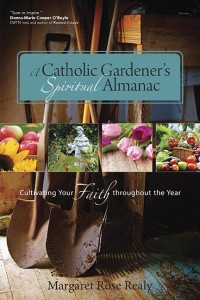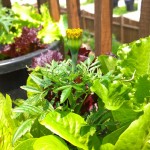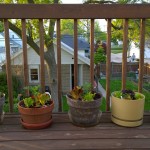One of the best things about blogging is being able to preview marvelous books and interview their marvelous authors. Margaret Rose Realy is one of those marvelous authors and I recently caught up with her to get the scoop on her newest book, A Catholic Gardener’s Spiritual Almanac: Cultivating Your Faith Throughout the Year (Ave Maria Press, March 2015). Realy was so kind to take time to answer a few questions for me about her book and the process of bringing it to life.
Here;s what we talked about:
Q: Every book has an interesting back story. No doubt A Catholic Gardener’s Almanac does, too. Briefly, what’s the back story? Can you tell us what that “aha” moment was like when you realized God was calling you to write this book?
A: The back story for A Catholic Gardener’s Spiritual Almanac begins before my first book was published. The two books, the first A Garden of Visible Prayer and this, my third, are closely intertwined—companion books if you will.
I’m a gardener, and always have been. Several years ago, as a result of an auto accident decades earlier, my spine became arthritic to the point of my being disabled. It was devastating to face losing my ability to garden; it was my love, livelihood, and identity.
I fell into darkness. Uncertain and anxious, I went often to Adoration. I cried with Jesus, that having been given this gift as a gardener, and now unable to work the ground, what was I to do? It took some time for me to surrender my emotional and physical pain, and to start listening. And what I heard was dumbfounding.
I was to write about gardens, about finding the Creator through his creation.
That may sound unremarkable to most, but I failed English classes in college. My first response to this call to write was “Seriously!? You’ve got to be kidding.” I wasn’t eager to be publicly humiliated due to my lack of skill when it came to writing. In a relatively short time, and a few astonishing events, I submitted in obedience. The Good Lord then placed several people in my path to help me grow into an industry I knew nothing about.
The first book was picked up by Circle Media. In a meeting between the editors the idea came for a book about Catholic traditions in gardens and I was asked to produce something along those lines, and did. They closed down their book division before either book was published.
A second publishing house picked up the first book, and they, too, asked about my writing a Catholic gardens book. I was astonished. I was also hesitant and didn’t say no outright—the topic felt too important for such a small publisher. Good thing I waited because they also closed down their book division. The first book is now in its second edition with a third publisher.
The manuscript for the Catholic gardens book was then pitched to one publisher while behind the scenes Lisa Hendey of Catholicmom.com—who had reviewed this book for the Catholic Writers Guild Seal of Approval—had suggested it to the Ave Maria Press folks. The first publishing house declined a contract and shortly thereafter Bob Hamma from AMP contacted me expressing interest in the title.
Bob and I worked out a format to expand the original manuscript, which combined another manuscript I had in flow, and added stories and bits of fun facts. The almanac was written, and there you have it.
Q: How did you become interested in gardening? Why is it important to you?
A: The love of plants was inborn. I can remember being about three or four, lying on my belly nose-to-petal with Creeping Buttercup. I was fascinated by the tiny weed; the yellow color, why the petals didn’t fall off, how it trailed through the grass. My parents’ business was greenhousing, so I grew up with an awareness of seasons and plants—mind you that impression was skewed by retailing. I don’t think I really appreciated or understood gardening until I lived with my maternal grandmother. It was then that the concept of what became of greenhouse plants in the landscape took hold, and my love of gardens blossomed.
Gardening is important to me because of the solitude and contemplative nature of the activity. I prefer silence and being alone. It wasn’t until I was in my late forties that I realized a hermitic life and how, for me, it was connected to the contemplative solitude of nature.
Q: What do gardening and spirituality have in common?
A: That is a broad question (and being addressed in the next book!) that I’ll try and answer in one paragraph.
In both, we are drawn to Our Lord. When we garden we caress the very hand of God, his creation. In recognizing this we cannot help but grow spiritually through wonderment and awe and come to know God’s love for us. It is in this being so loved we hunger to love back, and seek the Christ, through whom we gain access to the Father. There is an abundance of learning to be gleaned working with the good earth. For those of us who garden as a contemplative activity, the two—gardening and spirituality—are inseparable.
Q: How has writing this book affected your own spiritual journey?
A: It gave foundation to obedience and to trust the Holy in the daily. Whenever I would try to look into the future of this unintended writing career I felt inadequate. There were so many amazing writers who strung words with competence and beauty that I would feel intimidated by my simplicity. What I learned was to persevere at staying in the moment, to work incrementally, and to wait patiently. Somehow help and guidance always came in God’s good time not mine.
Q: What are you hoping readers will take away from your book?
A: A friend, Sister Anne Marie Walsh, shared with me the words of St. Basil the Great. His words best answer this question. “I want to awaken in you a deep admiration for creation, until you in every place, contemplating plants and flowers are overcome by a living remembrance of the Creator…I want creation to penetrate you with so much admiration that wherever you go, the least plant may bring you a clear remembrance of the Creator…one blade of grass or one speck of dust be enough to occupy your entire mind in beholding the art with which it has been made.”
To purchase your copy of A Catholic Gardener’s Almanac, click here.













